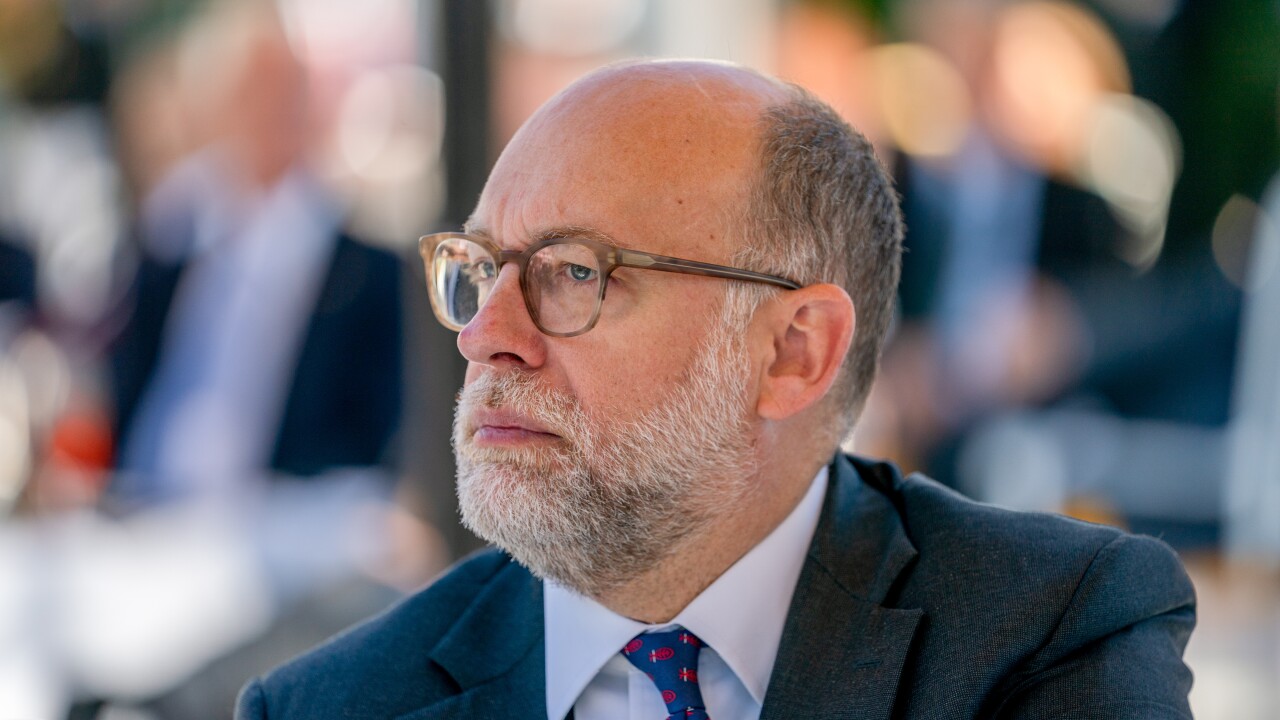(Bloomberg) -- As Donald Trump ramps up efforts to control the Federal Reserve, investors worry he'll use central bank tools to fix something that's not supposed to be a central bank problem: America's ballooning debt bills.
Trump said Tuesday he's ready for a legal fight over his attempt to oust Fed Governor Lisa Cook, and looking forward to having a "majority" on the central bank's board. That could advance the president's campaign for lower interest rates, which he says will save the country "hundreds of billions."
There are two main reasons why the government's debt costs have soared lately: bigger budget deficits and higher rates. At least one of them will have to go into reverse if the bill is to come back down. But most economists say the solution lies in borrowing less, via some combination of lower spending and higher taxes — rather than leaning on the Fed to make borrowing cheaper.
The latter path is a dangerous one for central bankers whose goal is to keep a lid on inflation. The task can be harder anyway when politicians keep juicing the economy by pumping in money. It risks becoming impossible if interest rates – the main lever for curbing price pressures – turn into a tool for keeping the government solvent instead.
The term economists use for this kind of scenario is "fiscal dominance." It's typically associated with emerging-market nations, where monetary policy is more subject to political pressure. As Trump's campaign against the Fed escalates, many analysts see the US sliding in a similar direction.
Eric Leeper, an economics professor at the University of Virginia, reckons it's already there.
"Ultimately it's fiscal policy that needs to be in place in the right way if you're going to keep inflation under control," says Leeper, a former Fed economist. Instead, "what we hear is, we need lower interest rates because interest payments are exploding," he says. "It's admitting that fiscal policy is not going to take care of itself, and so they're trying to find some other way out. This is fiscal dominance."
'Wouldn't Be Good'
To be sure, even investors and economists who worry about such risks wouldn't all go that far.
There's no sign that interest-rate decisions have been swayed by the state of US public finances. To tame post-Covid inflation, Fed officials enacted the sharpest rate hikes since the 1980s – even though that added hundreds of billions of dollars in debt costs to the budget.
This year, as the Fed held rates steady amid concern about tariff-led inflation, Chair Jerome Powell has insisted that policy is based solely on the economic outlook, a point he reiterated at Jackson Hole. Powell has often said US debt is on an unsustainable path. But he told reporters last month that it "wouldn't be good" to set policy in consideration of the government's fiscal needs, adding that "no advanced-economy central bank does that."
Still, there's mounting concern that the Fed might end up doing precisely that.
Trump will get to pick a successor to Powell, whose term as chair ends next May. The president already named his economic adviser Stephen Miran to fill one vacancy on the Fed board, and will create another one if his attempt to fire Cook over alleged financial misconduct is successful. His team is hinting at a wider overhaul, and looking for ways to exert more influence over the Fed's 12 regional banks. Behind all this there's a steady drumbeat of demands for lower rates.
"The Fed is now subject to intensifying fiscal dominance risks," George Saravelos — global head of FX research at Deutsche Bank AG — wrote in a report Tuesday. "What is a bigger surprise to us is that the market is not more concerned."
Thirty-year Treasury bonds and the dollar posted declines on Tuesday as Trump pressed ahead with his bid to oust Cook. Both are still trading well above the lows reached earlier this year amid concern over US trade and budget plans.
Fears of a shift in the Fed's focus would undermine the greenback and lift bond yields, while potentially generating interest in crypto currencies and gold as alternatives, according to Steve Barrow, head of G-10 strategy at Standard Bank in London. More than half of fund managers in a recent Bank of America Corp. poll said they expect the next Fed chair to resort to quantitative easing or yield curve control — policies that involve buying government bonds to cap borrowing costs — in order to ease the US debt burden.
'Getting Closer'
As they browbeat the Fed, Trump and his allies have floated other ways to nudge down the government's debt expenses, too.
A proposed tweak to bank capital rules could boost demand for Treasuries, lowering their yield. So could the new law to regulate stablecoins, mandating issuers to back them with safe assets like government debt. There's talk of eking out some savings by issuing more short-term bonds. Republican Senator Ted Cruz has drafted legislation to bar the Fed from paying interest on reserves, touting the fiscal benefits it would bring.
All of these are indicators that budget pressure is increasingly shaping policy, according to David Beckworth, senior research fellow at the Mercatus Center at George Mason University. "We're not at the textbook definition of fiscal dominance, but we're getting closer," he says. "I'd say we're on that spectrum."
As for the budget itself, Trump pushed a tax-cut and spending bill through Congress this summer that's forecast to add $3.4 trillion to deficits over a decade. He's also created a new revenue stream with large tax hikes on imports.
Add those up and it's essentially a wash, S&P Global concluded. "Although fiscal deficit outcomes won't meaningfully improve, we don't project a persistent deterioration," the credit rating company wrote.
S&P predicts budget shortfalls of around 6% of GDP through the rest of Trump's term, roughly in line with other forecasters. That's smaller than in the Covid aftermath, but still large by historical standards – and double the 3% target set by Treasury Secretary Scott Bessent.
That leaves the US national debt on track for a peacetime record above 100% of GDP. It's built up under governments of both political parties, the result of rescue efforts during the Global Financial Crisis and the pandemic, coupled with reluctance to raise taxes or trim major budget items such as social welfare and defense.
When governments run deficits, they typically finance the extra spending by issuing more bonds. That's when central banks come into play. In crisis periods they can step in to buy the debt themselves. Even in normal times, they set the short-run interest rates that influence the cost of longer-term sovereign debt.
The two don't always move in tandem. "No matter what the administration in any country may desire, in the end interest rates are set by markets," said Fabio Natalucci, head of the Andersen Institute for Finance and Economics. "Especially at the long end of the curve."
One recent example: When the Fed was easing monetary policy late last year, yields on 10-year and 30-year Treasuries actually rose – partly on concern that bigger budget deficits after November's election would rekindle inflation.
That episode is a reminder that the Fed can't automatically deliver cheaper government borrowing — and also that rising public debt can cause problems for central bankers, who prefer it when bond markets are responsive to their moves.
Atlanta Fed President Raphael Bostic made the point in July, arguing that monetary policy could become less effective if investors worry about fiscal risk. "You could see interest rates move to some extent independent of things that we do," he said. "That would be really something that we'd have to think hard about."
'Who Blinks First?'
There's nothing unusual about fiscal and monetary policies pointing in opposite directions. What can be dangerous is when both sides keep pushing and neither is ready to give in.
"I think of this as a game of chicken," says George Hall, a professor at Brandeis University and former economist at the Chicago Fed. "Who blinks first? Is it going to be the Federal Reserve or is it going to be Congress and the president?"
Central banks need to win any such game to maintain their credibility as inflation-fighters, even if that means keeping rates high enough to make budget strains worse. Fiscal dominance is what happens when they lose, monetary policy becomes a tool of debt management, and price targets get watered down or even abandoned.
None of which applies in the US right now. Nor is there any sign of the kind of economic emergency that's tipped some countries into fiscal dominance in the past.
Instead the concern is a political one — that pressure on the Fed is "opening the door" to that kind of regime — according to Dario Perkins, an economist at TS Lombard in London.
"Every week Trump says very clearly that these high interest rates are costing the government money," he said. "It's very clearly linked to debt problems rather than the inflation issue."
--With assistance from Jonnelle Marte and Derek Wallbank.
More stories like this are available on bloomberg.com





